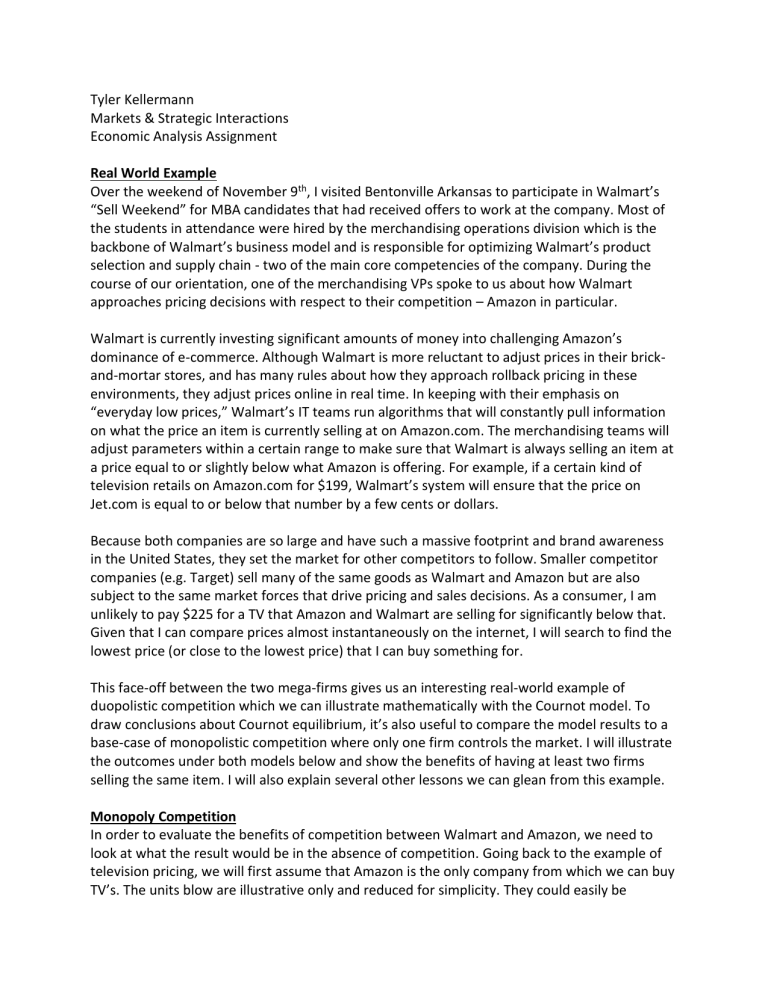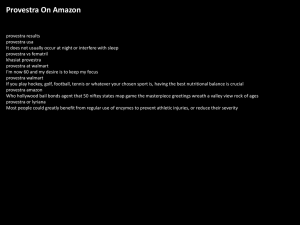Economic Analysis Assignment
advertisement

Tyler Kellermann Markets & Strategic Interactions Economic Analysis Assignment Real World Example Over the weekend of November 9th, I visited Bentonville Arkansas to participate in Walmart’s “Sell Weekend” for MBA candidates that had received offers to work at the company. Most of the students in attendance were hired by the merchandising operations division which is the backbone of Walmart’s business model and is responsible for optimizing Walmart’s product selection and supply chain - two of the main core competencies of the company. During the course of our orientation, one of the merchandising VPs spoke to us about how Walmart approaches pricing decisions with respect to their competition – Amazon in particular. Walmart is currently investing significant amounts of money into challenging Amazon’s dominance of e-commerce. Although Walmart is more reluctant to adjust prices in their brickand-mortar stores, and has many rules about how they approach rollback pricing in these environments, they adjust prices online in real time. In keeping with their emphasis on “everyday low prices,” Walmart’s IT teams run algorithms that will constantly pull information on what the price an item is currently selling at on Amazon.com. The merchandising teams will adjust parameters within a certain range to make sure that Walmart is always selling an item at a price equal to or slightly below what Amazon is offering. For example, if a certain kind of television retails on Amazon.com for $199, Walmart’s system will ensure that the price on Jet.com is equal to or below that number by a few cents or dollars. Because both companies are so large and have such a massive footprint and brand awareness in the United States, they set the market for other competitors to follow. Smaller competitor companies (e.g. Target) sell many of the same goods as Walmart and Amazon but are also subject to the same market forces that drive pricing and sales decisions. As a consumer, I am unlikely to pay $225 for a TV that Amazon and Walmart are selling for significantly below that. Given that I can compare prices almost instantaneously on the internet, I will search to find the lowest price (or close to the lowest price) that I can buy something for. This face-off between the two mega-firms gives us an interesting real-world example of duopolistic competition which we can illustrate mathematically with the Cournot model. To draw conclusions about Cournot equilibrium, it’s also useful to compare the model results to a base-case of monopolistic competition where only one firm controls the market. I will illustrate the outcomes under both models below and show the benefits of having at least two firms selling the same item. I will also explain several other lessons we can glean from this example. Monopoly Competition In order to evaluate the benefits of competition between Walmart and Amazon, we need to look at what the result would be in the absence of competition. Going back to the example of television pricing, we will first assume that Amazon is the only company from which we can buy TV’s. The units blow are illustrative only and reduced for simplicity. They could easily be multiplied by several orders of magnitude. Under the monopoly model, we will assume that Amazon’s Q* (quantity produced) is the company’s annual sales volume and they are choosing how many units to sell and what price to sell them at to maximize their profit. Assumptions Amazon Demand Function: 𝑃 = 50 – 2𝑄 Amazon Cost Function: 𝐶 = 10 + 2𝑄 Production until 𝑀𝑅 = 𝑀𝐶 Solution = 𝑃𝑄 – 𝐶 = (50 – 2𝑄)𝑄 – (10 + 2𝑄) = 50𝑄 – 2𝑄 2 – 10 – 2𝑄 = 48𝑄 – 2𝑄 2 – 10 𝜕 𝜕𝑞 = 48 − 4𝑄 = 0 48 = 4𝑄 𝑄 ∗ = 12 𝑃 = 50 – 2𝑄 𝑃 = 50 – 2(12) 𝑃∗ = 26 We see that under these conditions, Amazon “produces” (sells) 12 TVs for which it charges $26 dollars each. Given that this is a monopoly scenario, we also can conclude that Q* and P* are respectively lower and higher than they would otherwise be under perfect competition. Cournot Competition Now that we have seen the most market-inefficient outcome, we can illustrate the benefits of Walmart entering the ecommerce market to challenge Amazon’s dominance of TV sales. We will now assume that Walmart has entered the market and is competing in Cournot duopoly with Amazon. Both Walmart and Amazon decide on their sales volume simultaneously. Also, because they are such large corporations, we will assume that they face the same cost functions because their size allows them to optimize in similar ways and gives them the same leverage with suppliers. Assumptions Demand Function (Both Firms): 𝑃 = 50 – 2𝑄 Cost Function (Both Firms): 𝐶 = 10 + 2𝑄 Production until 𝑀𝑅 = 𝑀𝐶 Solution 1 = 𝑃𝑄1 – 𝐶1 = [50 – 2(𝑄1 + 𝑄2 )]𝑄1 – 10 – 2𝑄1 = 50𝑄1 – 2𝑄12 – 2𝑄1 𝑄2 – 10 – 2𝑄 𝜕1 = 50 – 4𝑄1 – 2𝑄2 – 2 𝜕𝑞 1 𝑄1 = 12 − 0.5𝑄2 Firm 1 Reaction Function 𝑄2 = 12 − 0.5𝑄1 Firm 2 Reaction Function (symmetrical due to same assumptions) 𝑄1 = 12 − 0.5(12 − 0.5𝑄1 ) 𝑄1 = 12 − 6 + 0.25𝑄1 0.75𝑄1 = 6 𝑄1∗ = 8 𝑄2∗ = 8 𝑄 ∗ = 𝑄1∗ + 𝑄2∗ 𝑄 ∗ = 16 𝑃 = 50 − 2𝑄 𝑃 = 50 – 2(16) 𝑃∗ = 18 Under Cournot competition, quantity sold increases by 4 and price decreases by 6 resulting in a significant gain of consumer surplus and a reduction of deadweight loss due to monopoly inefficiency. This model shows that consumers benefit when there are at least two firms in the market compared to monopoly conditions. Model Weaknesses In this case, I have modeled the duopolistic competition between Walmart and Amazon as a Cournot equilibrium. However, a major flaw with this approach is that the Cournot model suggests that, like monopolistic competition, the companies involved are making simultaneous decisions about quantity rather than price. In reality, what we see with Amazon vs. Walmart is more similar to a Bertrand duopoly. Under the Bertrand model, the firms are making decisions about price, not quantity. Due to the fact that each firm can constantly undercut the other and will adjust their reaction functions based on the action of the rival firm, the Bertrand model usually approaches perfect competition as long as we assume the firms do not collude in setting prices. The functions I used to illustrate monopoly and Cournot competition above do not work well with the Bertrand model because the units will cancel each other in the reaction functions. However, under Bertrand conditions more units will be sold at lower prices than would happen under Cournot equilibrium, resulting in a further gain to consumer surplus. Another weakness of the modeling above is that it assumes the firms sell homogenous, indistinguishable products and a consumer would be equally happy purchasing from either supplier. In reality, nearly all consumer products are branded and have different levels of consumer loyalty attached to them. Walmart and Amazon themselves are brands. This model does not address the fact that a consumer may be willing to pay $1 more for a TV from Amazon because they have both a Prime membership, a lot of experience ordering from Amazon, and comfort with the brand. Finally, the equations I chose above assume that Walmart and Amazon have equal market power and therefore face the same demand, cost, and reaction functions. Because the real world is imperfect, there could be many situations where one company has an advantage over the other. Even if they face the same conditions with regard to televisions, Walmart may have an edge in produce because it has more experience selling fresh fruits and vegetables and negotiating with farm suppliers. Conversely, Amazon has significantly more revenue streams than Walmart (e.g. AWS, Kindle, etc.) and likely has more leverage over B2C shipping companies like UPS because it ships more packages through online sales than Walmart. These differences are not reflected in the models above. Model Predictions As we have seen mathematically, we would expect that consumers benefit when at least two large competitors are present in the marketplace. I would expect that due to price undercutting, the two firms would squeeze each other’s profit margins as well as put significant downward price pressure on smaller players. In the past, Walmart has been barraged with criticism about how its business model has put smaller retailers out of business. Small companies cannot match Walmart’s aggressive cost-cutting and economies of scale. I would expect that increased competition with Amazon will result in even more centralization in the retail industry and will make it very difficult for other companies to compete on price alone. We should expect that Target will continue to embrace its strategy of differentiation and double-down on producing and selling items with higher design aesthetics. Small businesses will have to compete on service quality if they wish to remain afloat. In the longer term, especially if growth trends of both behemoths continue at the same pace, we may see anti-trust regulators in the U.S. take an interest in the retail industry. Walmart saw nearly a 45% growth in its ecommerce business in the last quarter. Amazon continues to post strong revenue growth. These trends indicate more consolidation in the retail industry for both brick and mortar and ecommerce sales. The Hamilton Project, part of the Brookings Institution, has tracked the growth in the Herfindahl-Hirschman Index for a variety of industries and reported a large growth in the HHI index for the retail sector over the last several decades – several times above the DOJ horizontal merger threshold:1 1 “Firm concentration is rising, particularly in retail and finance,” The Hamilton Project, June 13, 2018, accessed November 19, 2018, http://www.hamiltonproject.org/charts/firm_concentration_is_rising_particularly_in_retail_and_finance Another broad concern is the effect that this dynamic will have on wages. Apple, Google and a handful of other technology companies were fined over $400 million in 2014 for colluding in the hiring market. The firms agreed not to hire employees of each other which kept wages down and reduced competition for talent in the technology industry. I see a risk that Walmart and Amazon could do the same, especially as their business models evolve to become more similar to each other. As Walmart expands its ecommerce footprint, Amazon is buying or building more brick and mortar stores through its acquisition of Whole Foods and rollout of automated convenience stores. It would be unsurprising if the two firms were tempted to rig the labor market to protect to their profits, especially given the fact that margins are so small in retail to begin with.



